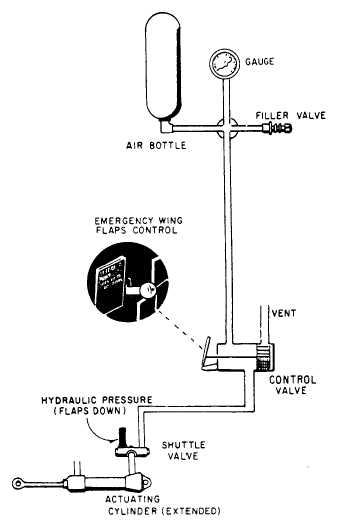level of cleanliness must be maintained when working
on hydraulic components.
Only approved fill stand units are used to service
naval aircraft hydraulic systems. By following a few
basic rules, you can service hydraulic systems safely
and keep contamination to a minimum.
! Never use fluid that has been left open for an
undetermined period of time. Hydraulic fluid
that is exposed to air will absorb dust and dirt.
! Never pour fluid from one container into
another.
! Use only approved servicing units for the
specific aircraft.
! Maintain hydraulic fluid-handling equipment
in a high state of cleanliness.
! Always make sure you use the correct
hydraulic fluid.
Contamination of the hydraulic system may be
caused by wear or failure of hydraulic components and
seals. This type of contamination is usually found
through filter inspection and fluid analysis. Continued
operation of a contaminated system may cause
malfunctioning
or
early
failure
of
hydraulic
components.
Q4-20.
What are two disadvantages of a hydraulic
system?
Q4-21.
On a basic hydraulic system, what is the
purpose of the selector valve?
Q4-22.
On a basic hydraulic system, what is the
purpose of the actuating unit?
Q4-23.
Define hydraulic contamination.
PNEUMATIC SYSTEMS
LEARNING OBJECTIVE:
Identify the
components of aircraft pneumatic systems and
recognize their functions.
There are two types of pneumatic systems currently
used in naval aircraft. One type uses storage bottles for
an air source, and the other has its own air compressor.
Generally, the storage bottle system is used only for
emergency operation. See figure 4-23. This system has
an air bottle, a control valve in the cockpit for releasing
the contents of the cylinders, and a ground charge
(filler) valve. The storage bottle must be filled with
compressed air or nitrogen prior to flight. Air storage
cylinder pneumatic systems are in use for emergency
brakes, emergency landing gear extension, emergency
flap extension, and for canopy release mechanisms.
When the control valve is properly positioned, the
compressed air in the storage bottle is routed through
the shuttle valve to the actuating cylinder.
NOTE:
The shuttle valve is a pressure-operated
valve that separates the normal hydraulic system from
the emergency pneumatic system. When the control
handle is returned to the normal position, the air
pressure in the lines is vented overboard through the
vent port of the control valve.
The other type of pneumatic system in use has its
own air compressor. It also has other equipment
necessary
to
maintain
an
adequate
supply
of
compressed air during flight. Most systems of this type
must be serviced on the ground prior to flight. The air
4-21
ANf0423
Figure 4-23.—Emergency pneumatic system.

